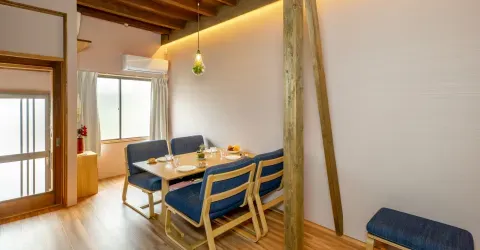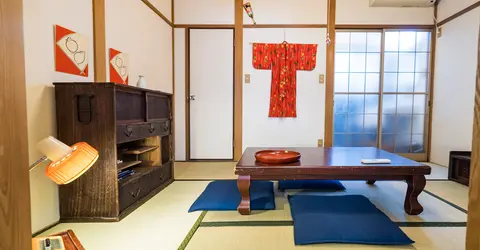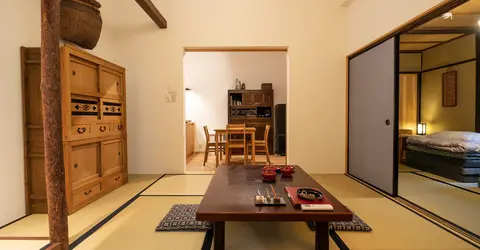Old Secluded Residence of Iwakura Tomomi
The Old Secluded Residence of Iwakura Tomomi is the historic retreat of the imperial court noble Iwakura Tomomi (1825-1883) in the north east of Kyoto.
The Old Secluded Residence of Iwakura Tomomi 岩倉具視幽棲旧宅
The Old Secluded Residence of Iwakura Tomomi (Iwakura Tomomi Yusei Kyutaku) is a preserved residence of Iwakura Tomomi, an important court noble and influential politician during the turbulent mid-nineteenth century Bakumatsu period of Japanese history. The residence is located in Iwakura, a quiet suburb in the north east of Kyoto.
It was at this time, in the late Edo Period of the 1850's and 1860's, after the appearance of Commodore Perry and a foreign threat to the nation, that control of the country passed from the Tokugawa shogunate to the new Meiji government centered on the person of the Japanese Emperor.
Iwakura Tomomi (1825-1883) was a pivotal figure in these important political events and intrigues centered on the capital of Kyoto.
 Old Secluded Residence of Iwakura Tomomi, Kyoto
Old Secluded Residence of Iwakura Tomomi, Kyoto The Old Secluded Residence of Iwakura Tomomi, Iwakura, Kyoto
The Old Secluded Residence of Iwakura Tomomi, Iwakura, Kyoto
Adopted into a family of court nobles surrounding the Emperor in the Imperial Palace (Gosho), Iwakura rose to become chamberlain to Emperor Komei (1831-1867).
With the arrival of Perry's US flotilla in Shimoda in 1853, Iwakura, like most of the Emperor's advisors, supported a policy of no compromise with the foreign interlopers, a policy called sonno-joi (尊皇攘夷, Revere the emperor, expel the barbarian), while the Tokugawa government was forced into a number of practical compromises with the foreign powers.
Over time Iwakura began to favor a new policy of reconciliation between court and the shogunate called kobu gattai (公武合体, unity of Court and Bakufu) and backed a marriage between the Emperor's sister, Princess Kazunomiya Chikako, and the Shogun, Tokugawa Iemochi. Iwakura accompanied the Princess on her long, sad journey along the Nakasendo highway to Edo Castle for her marriage.
However, the union was not well regarded by the Emperor, radical loyalists at court, or even by the princess herself, and Iwakura was forced to seek self-imposed exile in the suburb of Iwakura, where his family had connections, in the north east of Kyoto beneath Mt. Hiei. His life may have been in danger and he needed to distance himself from the court in central Kyoto.
 Old Secluded Residence of Iwakura Tomomi, Kyoto
Old Secluded Residence of Iwakura Tomomi, Kyoto Old Secluded Residence of Iwakura Tomomi, Kyoto
Old Secluded Residence of Iwakura Tomomi, Kyoto
Iwakura lived here for five years between 1863-1867 and the residence became a clandestine meeting place for the central plotters in the plans to overthrow the Tokugawa regime. Men such as Sakamoto Ryoma, Okubo Toshimichi and Kido Takayoshi are believed to have visited Iwakura here.
The Emperor Komei died in 1867 at the young age of 35. Some historians believe Iwakura may have had a hand in his death from smallpox by arranging for a handkerchief from a smallpox sufferer to be smuggled into the royal presence.
Along with Okubo Toshimichi and Saigo Takamori, Iwakura arranged for the Imperial Palace to be taken over by forces from the domains of Satsuma and Choshu (today's Kagoshima and Yamaguchi prefectures) on January 3, 1868. The Meiji Restoration was born.
After the accession of the compliant, 15 year-old Emperor Meiji and the establishment of a modernizing and westernizing Meiji government, Iwakura became the "Minister of the Right" in the new bureaucracy.
Iwakura played a central role in the promulgation of the Five Charter Oath of 1868, which set out the aims of the new order and the abolition of the domains (han) in 1871.
He led the Iwakura Mission of 1872-1873 when he, Ito Hirobumi and Kido Takayoshi traveled to the USA and Europe with some 40 other Japanese government officials and around 60 students to study western systems of government and industry.
The residence consists of two buildings, one a thatched Japanese-style house with tatami and the other a more western style brick structure.
Old Secluded Residence of Iwakura Tomomi Access
Old Secluded Residence of Iwakura Tomomi
Agura-cho 100, Iwakura, Sakyo-ku, Kyoto 606-0017
Tel: 075 781 7984
Hours: 9 am-5 pm (last entry 4.30 pm)
Closed Wednesday, but open on when Wednesday falls on a public holiday, and closed the next day, Thursday.
Closed December 29 - January 3
Admission: 300 yen for adults, 200 yen for junior/senior high school age, 100 yen for elementary school age.
The Old Secluded Residence of Iwakura Tomomi is a short walk from Jissoin Temple.
From Kyoto Station take a Kyoto subway Karasuma Line train to Kokusaikaikan and then a #24 Kyoto bus which terminates at Jissoin Temple. This is not within the Kyoto City Bus & Kyoto Bus One-day Pass (500 yen) zone so the fare is a further 170 yen.
Alternatively take buses #21 or #23 from Shijo Kawaramachi Station or from Demachiyanagi Station take the Eiden train to Iwakura Station and then a 20 minute walk or pick up a #21 or #23 bus from Demachiyanagi.
 Old Secluded Residence of Iwakura Tomomi, Iwakura, Kyoto
Old Secluded Residence of Iwakura Tomomi, Iwakura, Kyoto






























